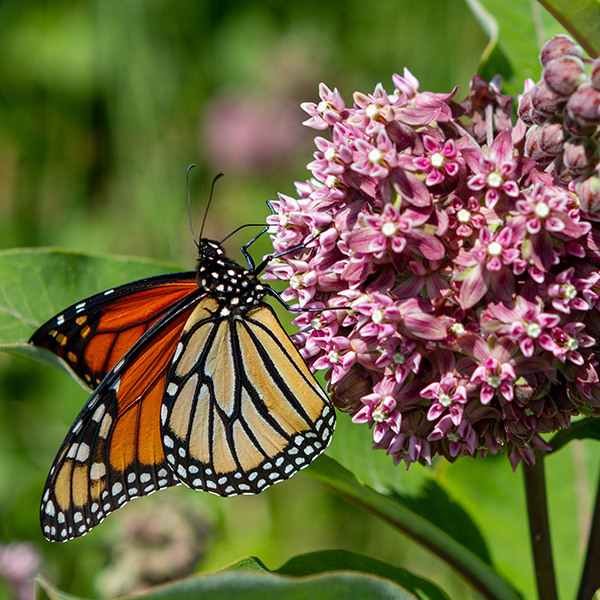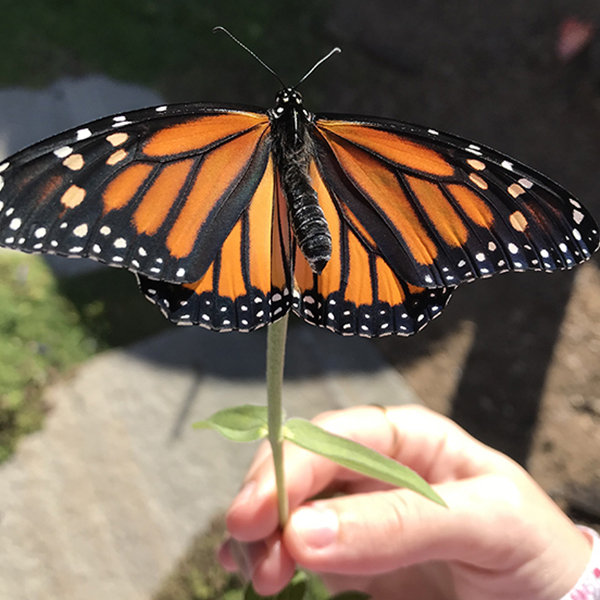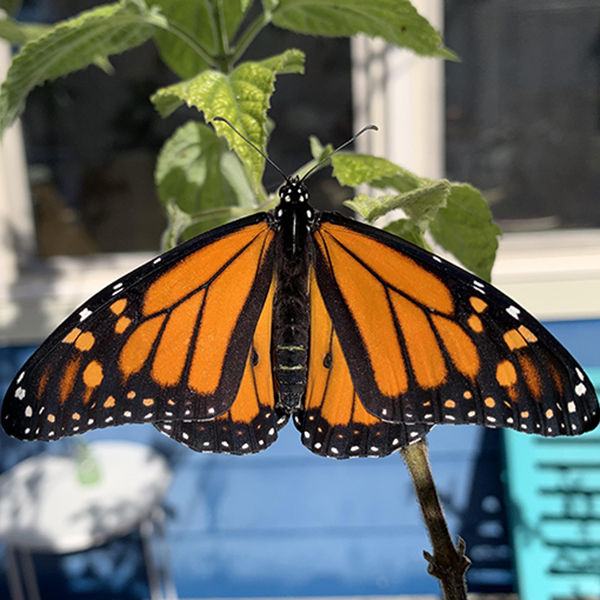

The Western Monarch is in Peril
by kim Young
 The western monarch butterfly (Danas plexippus) is in peril and not just dire but enough to be of such concern that in 2014 a petition was submitted to the United States Fish and Wildlife for consideration as an endangered species. On December 15th, 2020 we finally got that decision, United States Fish and Wildlife Service (USFWS) deemed the western monarch butterfly was “warranted but precluded” to be put on the Endangered Species Act. Western monarch butterflies are in what is called an extinction vortex. Western monarchs have declined from millions in the ’80s to less than 2,000 from the current western monarch Thanksgiving count done by the Xerces Society every year. What is of more concern is another count is done at New Years and typically there is about a 40% reduction in butterflies from the Thanksgiving count to the New Year’s count.
The western monarch butterfly (Danas plexippus) is in peril and not just dire but enough to be of such concern that in 2014 a petition was submitted to the United States Fish and Wildlife for consideration as an endangered species. On December 15th, 2020 we finally got that decision, United States Fish and Wildlife Service (USFWS) deemed the western monarch butterfly was “warranted but precluded” to be put on the Endangered Species Act. Western monarch butterflies are in what is called an extinction vortex. Western monarchs have declined from millions in the ’80s to less than 2,000 from the current western monarch Thanksgiving count done by the Xerces Society every year. What is of more concern is another count is done at New Years and typically there is about a 40% reduction in butterflies from the Thanksgiving count to the New Year’s count.
Much is needed to save this iconic butterfly but the actions needed to take a concerned collective effort from cities, large landowners, many private landowners, and citizen scientists. The thing that we can do on the central coast is plant habitat, lots of nectar plants for the monarch butterflies. Planting nectar plants give them much needed fuel for their migration and breeding cycle.
I am a Monterey Peninsula native. I was born in Carmel and grew up on the Monterey Peninsula and remember looking up from the playground in the fall and seeing thousands of monarch butterflies flying overhead returning to the overwintering sites along the central coast. Also, our local school district from kindergarten on always had the monarch butterfly in our curriculum. This butterfly has often stirred immense desire to work diligently to save it and yet we are now facing a most dire situation. What can be done, I’m often asked. Many try to plant more milkweed but milkweed alone will not save monarchs. There is no one reason but many reasons why the numbers keep falling of this iconic butterfly. It is degradation of over-wintering sites, loss of habitat, climate change, our summers are getting hotter and the wildfires have contributed to a loss of habitat, loss of native plants and chemical use regarding insecticides and herbicides. There was a current study that sampled milkweed and found pesticide contamination in all samples. Their findings found 25 different insecticides 27 fungicides, 11 herbicides and 1 adjuvant.
It is important to note that Tropical milkweed (Asclepias curassavica) commonly sold in box stores and a colorful milkweed but should be avoided in planting as it has been problematic regarding OE (Ophryocysis elektroscirrha) a debilitating protozoan parasite that infects monarchs and can possibly be contributing to the decline as well. One of the other factors of tropical milkweed which is not a native milkweed and such does not die back in the winter as native milkweeds do is continue to grow year-round on the central coast. The OE spores continue to collect on the plant and since the plant does not get cut back or die the monarchs stay to feed and lay eggs and not go into diapause (a form of rest, of suspended development during the winter) and then when conditions are favorable such as temperature and season change the monarch begins their migration and leave over-wintering sites breeding, looking for milkweed and nectar for their migration journey. Milkweeds should not be planted in areas that are within five miles of the coast as they were not historically growing there and as to not disrupt the reproductive cycle of the monarch butterflies. Also, there is a concern from the latest studies that hand-raising monarch butterflies can contribute to weakening their migratory instincts and also alter their DNA. Then quite possibly as they mate with wild monarchs weaken and alter the gene pool.
The decline of the monarch butterfly began in the 1980s and continues today but there is hope. Many species have been brought back. There is hard work ahead of us for it will take a collective effort to bring up the numbers. Please contact the Xerces Society xerces.org for more information.
Observing Monarchs Magical Daily Dance
by mimi chappelear

butterfly
The female monarch butterfly lays a tiny egg on the underside of a milkweed leaf or on top of the plant.

The Egg
The egg stage lasts from 4 to 8 days. When the egg hatches, the caterpillar will eat the eggshell from the inside until it emerges and there it will continue to feast on the leaf.

tiny caterpillar
The caterpillar stage lasts between 10 to 14 days.

adult caterpillar
Caterpillars do not stay in this stage very long as they quickly double in size in just a few days.

green chrysalis
Inside the chrysalis, the caterpillar is rapidly changing. The body of the caterpillar is undergoing a transformation, called ‘metamorphosis,’ to become the beautiful monarch butterfly that will emerge.

transparent chrysalis
The chrysalis becomes transparent and the wings can be seen as clear as day. At this stage, the butterfly will come out at any moment!

Male butterfly
The male Monarch Butterfly can be easily distinguished from the female. The male has two highly visible black spots on the insect’s hind wings and the black webbing is thinner.

Female butterfly
Unlike the male monarch, the female has thicker black webbing and does not have black spots on each side of the wings.
Butterfly Gardening
Bring Beauty and Biodiversity to Your Yard
By Dana Abbott
Families working from home are discovering the rewards of butterfly gardening. Planting nectar flowers to attract butterflies, adds color to your yard and sustains a variety of pollinators, including hummingbirds and bees.
“I purposefully landscape with pollinators in mind,” says Kathy Reimer-Pearson, a docent at the Monarch Butterfly Trail at Natural Bridges State Park in Santa Cruz. Monarchs, painted ladies, buckeyes, and gray hairstreaks feed on the Mexican sunflowers and pincushions in Kathy’s yard.
“The gold fritillary love passion vine,” Kathy notes. Aside from the fresh air, and increase in bird life, gardening gives Kathy perspective on how dependent we are on butterflies to pollinate our food crops. Native plants delight an entire ecosystem of insects and birds, require minimal care, and thrive in our area. “Some native flowers attract so-called “specialist” butterflies that are drawn to one species of plant with specific characteristics,” says Taelor Whittington of Central Coast Wilds Nursery, in Santa Cruz.
Taelor recommends asking your local nursery where the plants have been sourced. Plant with seeds that have been collected locally but “if local genetics aren’t available,” says Taelor, “using plants from a similar ecoregion is a great next step.” Santa Cruz native shrubs and trees, including varieties of manzanita, blue blossoms, buckeyes, and yerba santa, can collaborate with flowers, such as salvias, buckwheats, seaside daisy, and yarrow in enticing butterflies to your yard. Loss of habitat, forest fires, and climate change have greatly reduced the butterfly population. Pesticides kill butterflies. Employ ladybugs, or a mild solution of dish soap and water, for aphids. Check the label on any plant soap for neonicotinoids, which kill pollinators. The Xerces Society For Invertebrate Conservation advises local residents to avoid planting milkweed within five miles of the coast. Planting milkweed too close to our coastal overwintering grounds can interrupt the monarch’s natural migration cycle, leading to a higher risk of mortality.
If you live inland, planting milkweed that is native to your area is the best option. Avoid tropical milkweed sold in many nurseries. This variety is a host to the “OE” parasite that disrupts the development of the monarch and decreases its survival.
The Xerces Society’s Western Monarch Thanksgiving Count for 2020 suggests that the monarch migration is at an all-time low. No monarchs showed up at the Pacific Grove Sanctuary as of early December, and only 550 monarchs were seen at Natural Bridges State Beach area this season. The Western Monarch population has declined by 99 percent, and may soon be classified as an Endangered Species by US Fish and Wildlife. Overall, most butterfly species are in decline in California, as reported at the low-elevation monitoring sites.
Informed gardeners can play a crucial role in helping butterflies survive. For more information and pollinator plant lists:
xerces.org | calscape.org


You May Also Like

New Year Editor Note
January 1, 2021
Bigfoot Coloring Page
January 1, 2021

